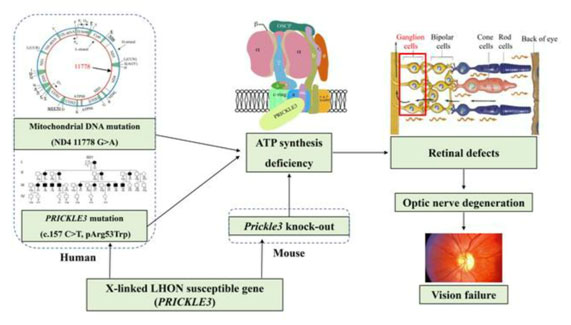June 9, 2020, the team of Professor Guan Minxin from the School of Medicine, Institute of Genetics of Zhejiang University published PRICKLE3 linked to ATPase biogenesis manifested Leber’s hereditary optic neuropathyonline in the international journal The Journal of Clinical Investigation, which is the latest progression of Leber’s hereditary optic neuropathy (LHON). After eight years of hard work, it was discovered for the first time that the mutation of the X-linked nuclear modification gene PRICKLE3 and mitochondrial mutation synergistically triggered LHON, which answered the 30-year-unsolved question, “gender bias”, of LHON. This is a milestone breakthrough in the research of mitochondrial disease LHON pathogenic mechanism.
Leber's hereditary optic neuropathy (LHON) is one of the most common maternal genetic diseases (female to male transmission), usually manifested as painless acute vision loss in both eyes, especially among young men aged 18-20. LHON is caused by genetic factors, environmental factors, or a combination of the two. MtDNA mutations are the main molecular basis of Leber's hereditary optic neuropathy, but its molecular pathogenic mechanism has not yet been fully clarified. In 1988, American professor Wallace first discovered that LHON is mainly caused by the lack of energy metabolism caused by mutations in three mitochondrial genes, m.11778G>A, m.14484T>C, and m.3460 G>A. The characteristics of penetrance and high incidence of males in different populations suggest that X-linked nuclear modification genes play a decisive role in the pathogenic mechanism of LHON. However, these genes have not been identified for thirty years,which is a recognized problem.
Professor Guan Minxin has long been engaged in the research of molecular pathogenic mechanism and clinical translation of maternal genetic diseases. Since 2003, Professor Guan has conducted a systematic and comprehensive study on the pathogenic mechanism of LHON in the Chinese population, exploring new strategies for disease diagnosis and prevention. He collaborated with many domestic units to collect the largest LHON cohort in the world, mapped the mutation spectrum of mitochondrial genes in the Chinese population, identified multiple new mutation sites and conducted functional studies. In 2016, the important role of autosomal nuclear modification gene YARS2 in the pathogenesis of LHON was first discovered. Relevant achievements have published more than 40 original series of papers in international authoritative journals such as OPHTHALMOLOGY, HUMAN MOLECULAR GENETICS, IOVS, etc., and have obtained 6 national authorized patents, and won the second prize of National Science and Technology Progress Award in 2007.
In this study, the team of Professor Guan Minxin conducted systematic large-scale gene screening of more than 200 Han ethnic LHON families, and discovered the X-linked gene PRICKLE3 through exome sequencing, biological information analysis and functional verification. Through a series of functional analysis of patient-derived cell lines and gene knockdown Hela cell lines, it was found that PRICKLE3 mutations affect the assembly, stability and function of mitochondrial ATP synthase, leading to abnormal energy metabolism. The PRICKLE3 mutation and the mitochondrial gene 11778G>A mutation work synergistically, which aggravates the mitochondrial energy metabolism disorder, resulting LHON. In addition, the PRICKLE3 knockout mice showed typical clinical phenotypes of LHON patients such as atrophy of optic ganglion cells and abnormal fundus blood vessels. This study revealed the synergy between mitochondrial mutation and X-linked nuclear modification gene mutation leading to the pathogenic mechanism of LHON, and solved the unsolved mystery of male prevalence. This is a major breakthrough in the research of the pathogenic mechanism of hereditary eye diseases. It provides theoretical basis and technical support for the precise diagnosis, intervention and treatment of LHON, and also has a reference significance for the precise intervention treatment of other maternal genetic eye diseases and other diseases.
As a medical scientist, in addition to publishing an original series of basic research papers (highly cited authors for six consecutive years), Professor Guan Minxin also actively writes popular science articles and clinical practice guidelines, and writes papers on the motherland.

Please refer to the link of this study https://www.jci.org/articles/view/134965